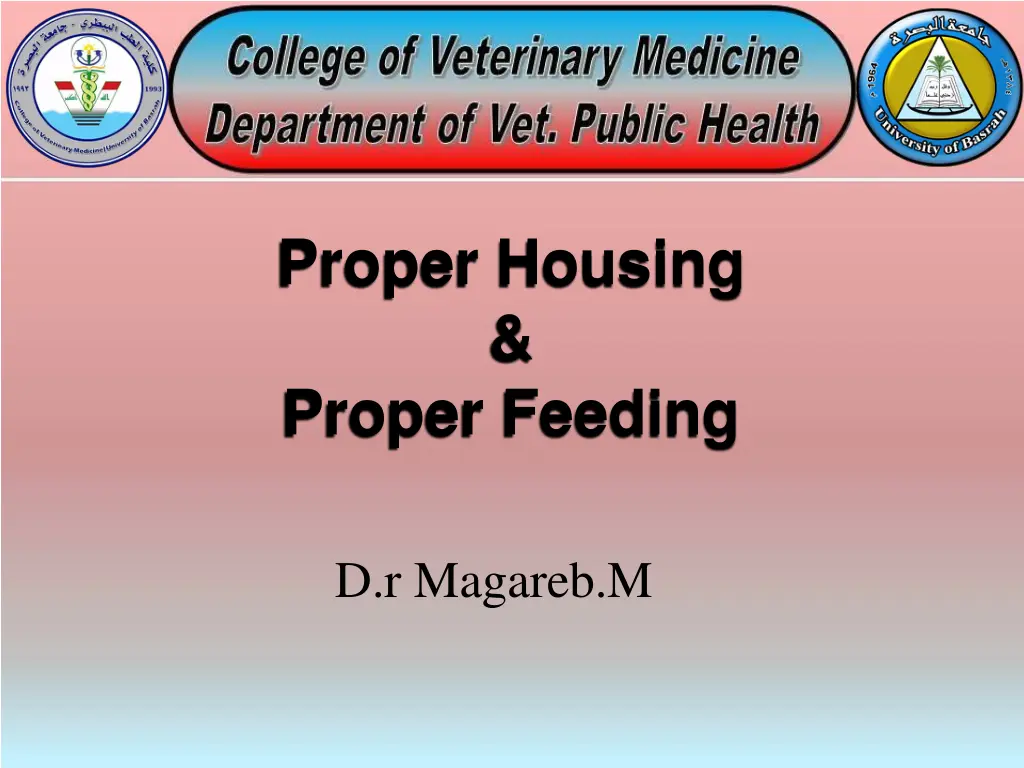
Proper Housing and Feeding Guidelines for Poultry
Learn about the importance of proper housing and feeding for poultry, including tips on avoiding overcrowding, stocking density recommendations, and essential nutrients for optimal growth and production. Discover how to maintain a healthy environment and prevent disease spread while providing nutritious feeds for different bird groups.
Download Presentation

Please find below an Image/Link to download the presentation.
The content on the website is provided AS IS for your information and personal use only. It may not be sold, licensed, or shared on other websites without obtaining consent from the author. If you encounter any issues during the download, it is possible that the publisher has removed the file from their server.
You are allowed to download the files provided on this website for personal or commercial use, subject to the condition that they are used lawfully. All files are the property of their respective owners.
The content on the website is provided AS IS for your information and personal use only. It may not be sold, licensed, or shared on other websites without obtaining consent from the author.
E N D
Presentation Transcript
Proper Housing & Proper Feeding D.r Magareb.M
Proper Housing: It is important for optimum growth and production as well as for proper maintenance of health. So we have to apply the following rules:- A. Overcrowding must be avoided. B. All-in all-out system of rearing is better than multistage rearing in a single location. All-in all-out method helps to prevent spread of diseases due to cross age infections. C. Poultry house should be kept dry and well ventilated. D. The design and construction of poultry houses should be made according to the environmental conditions of the particular area.
Stocking Density For breeders Males will reach a heavier weight than females so require extra floor space to ensure they reach their adult weight. Males and females must be grown separately for at least 6 weeks, or to 21 weeks. Brooding Males and females for the first 5 days stock at 30 chicks/square meter Rearing Females - 6 7 birds/square meter Males 3 4 birds/square meter Production Breeder Females - 3 5 birds/square meter Broilers 6-8wks 12 14/square meter Laying pullets 10/square meter Laying hens - max 5/box 60cm x 60 cm
Proper Feeding Poultry should be fed properly as per the age, type and production of birds, i.e., the quality and quantity of feeds and proper method of feeding should be maintained for optimum growth and production. A- Two types of feeds are given to the broilers (chicken), :broiler starter (0-4 weeks) and broiler finisher (5-6 weeks). In case of layers three types of feeds are provided:(1)chick feed (0-8 weeks),(2)grower feed (9-20 weeks or up to the point of laying) and(3)layer feed (21 weeks or from the point of laying to 72-80 weeks or up to the end of economic laying).
Proper Feeding B-Poultry feed should contain all essential nutrients, like, protein, carbohydrate, fat and moisture vitamins and minerals as per the requirements for a particular group of birds. C- Feed should be free from microbial contamination. Poultry feeds are very prone to different types of bacterial and fungal contamination, like., Salmonella, Escherichia coli, Mycoplasma, Aspergillus, etc.
Proper Feeding D-Feed ingredients having toxic principles like gossypol, aflatoxin, trypsin inhibitor etc. should not be used for preparation of poultry feed. E- Feeds should not be stored for more than 45days, particularly when environmental humidity is very high, in order to prevent the fungal growth and development of rancidity, besides the wastage of feeds due to rodents.
